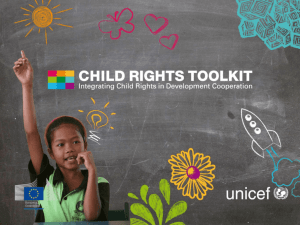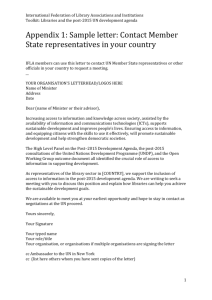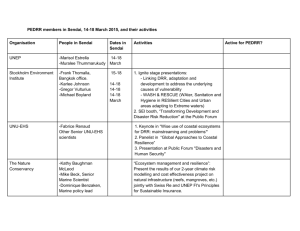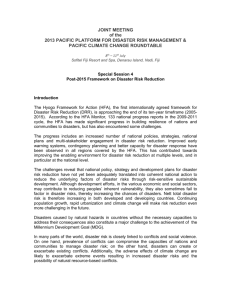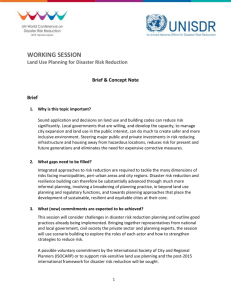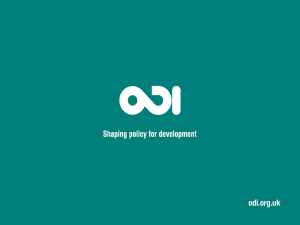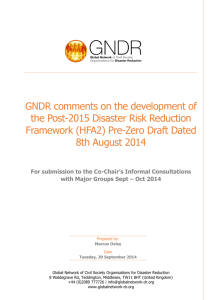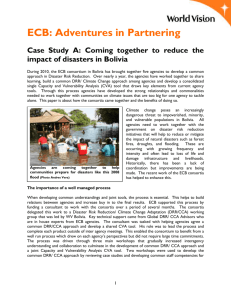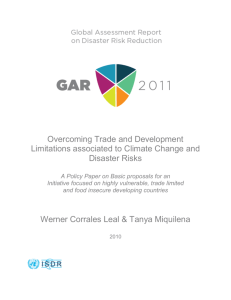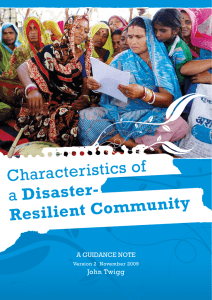UPAG statement on the zero draft of the post
advertisement
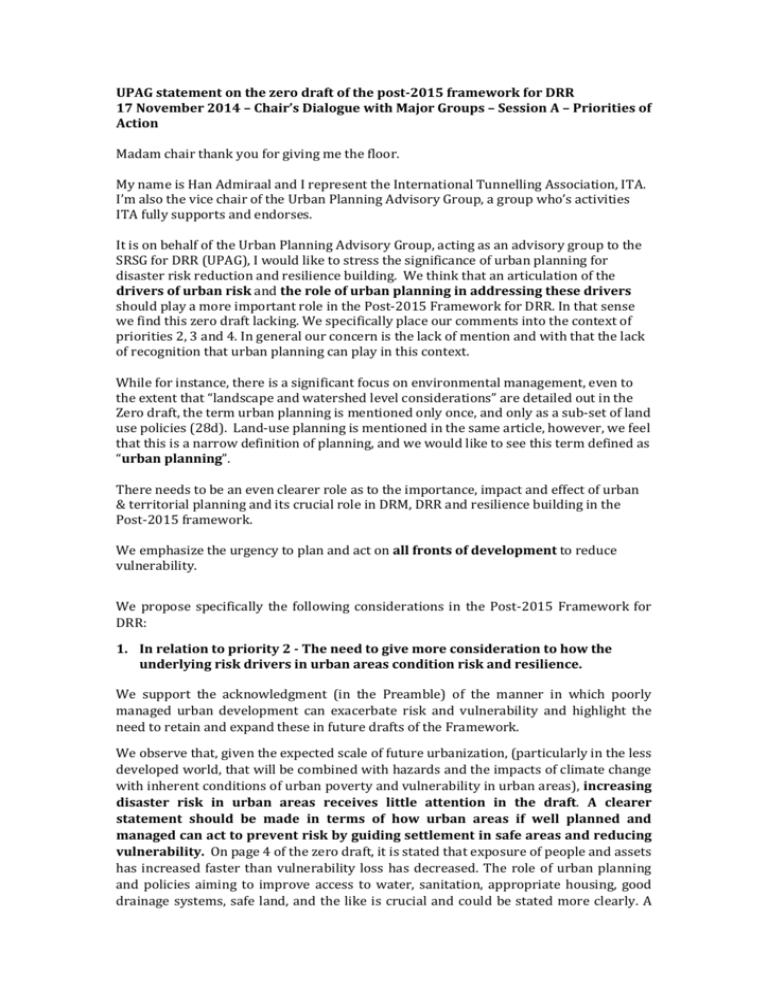
UPAG statement on the zero draft of the post-2015 framework for DRR 17 November 2014 – Chair’s Dialogue with Major Groups – Session A – Priorities of Action Madam chair thank you for giving me the floor. My name is Han Admiraal and I represent the International Tunnelling Association, ITA. I’m also the vice chair of the Urban Planning Advisory Group, a group who’s activities ITA fully supports and endorses. It is on behalf of the Urban Planning Advisory Group, acting as an advisory group to the SRSG for DRR (UPAG), I would like to stress the significance of urban planning for disaster risk reduction and resilience building. We think that an articulation of the drivers of urban risk and the role of urban planning in addressing these drivers should play a more important role in the Post-2015 Framework for DRR. In that sense we find this zero draft lacking. We specifically place our comments into the context of priorities 2, 3 and 4. In general our concern is the lack of mention and with that the lack of recognition that urban planning can play in this context. While for instance, there is a significant focus on environmental management, even to the extent that “landscape and watershed level considerations” are detailed out in the Zero draft, the term urban planning is mentioned only once, and only as a sub-set of land use policies (28d). Land-use planning is mentioned in the same article, however, we feel that this is a narrow definition of planning, and we would like to see this term defined as “urban planning”. There needs to be an even clearer role as to the importance, impact and effect of urban & territorial planning and its crucial role in DRM, DRR and resilience building in the Post-2015 framework. We emphasize the urgency to plan and act on all fronts of development to reduce vulnerability. We propose specifically the following considerations in the Post-2015 Framework for DRR: 1. In relation to priority 2 - The need to give more consideration to how the underlying risk drivers in urban areas condition risk and resilience. We support the acknowledgment (in the Preamble) of the manner in which poorly managed urban development can exacerbate risk and vulnerability and highlight the need to retain and expand these in future drafts of the Framework. We observe that, given the expected scale of future urbanization, (particularly in the less developed world, that will be combined with hazards and the impacts of climate change with inherent conditions of urban poverty and vulnerability in urban areas), increasing disaster risk in urban areas receives little attention in the draft. A clearer statement should be made in terms of how urban areas if well planned and managed can act to prevent risk by guiding settlement in safe areas and reducing vulnerability. On page 4 of the zero draft, it is stated that exposure of people and assets has increased faster than vulnerability loss has decreased. The role of urban planning and policies aiming to improve access to water, sanitation, appropriate housing, good drainage systems, safe land, and the like is crucial and could be stated more clearly. A city can work to address its problems of services and infrastructure, plan to have safe land available, work with and respond to the needs of all groups but specially to those of the most vulnerable, and guide urban growth following sustainable parameters and disaster risk prevention. 2. In relation to priority 3 - The need to consider urban planning as a contributor to priority action 3: Investing in economic, social, cultural and environmental Resilience. We suggest the post-2015 framework needs to emphasize the importance of urban planning as an integral part of investing in resilience. Urban planning can help bring the vision of future growth in line with the idea of long-term sustainable development such that new risks are avoided altogether. Urban planning is future looking, and at its best, urban planning can address the core of what resilience is all about. We want to stress that urban planning is a political process that involves (or should involve) different stakeholders in bringing about equity in access to land and urban services, including the empowerment of poorer and vulnerable citizens, for example through inclusive and participatory forms of planning. We think that this document should give greater outlook to the role of urban planning in accessing the basic infrastructure and services (water, sanitation, drainage, housing, etc), drawing the link that these have towards reducing underlying vulnerability. We need to understand that the pressure of the market on land and housing prices has become one of the major restrictions for poor families in accessing safe housing. Without land or houses economically accessible the alternative is to live in unsafe land or far from the centre of the city, both of these options are increasing risks and promoting the expansion of a city without infrastructure (There are some good examples in Latin American countries, e.g. Brazil, Colombia and Argentina, looking for mechanisms to control market pressure). Planning can be at the core of democratic management of cities, in order to guarantee a process of decision-making that includes active protagonists, participation and deliberation of the community, civil associations and organizations that promote access to safe places and housing. Urban planning is a very effective tool when it comes to resilience. With a well thought out and proper planning, you can plan ahead for avoiding disasters. Both with land-use planning and also on how to place critical infrastructure, hospitals, geriatric care, etc. By the use of suitable hazard micro-zonation maps, growth projections, building standards; inevitable economic and demographic concentration can be manipulated before it transpires into hard reality. We would like to emphasize that one of the needs underpinning planning is a body of critical and varied producers and consumers of data about hazards and vulnerability. This information is essential if understanding across urban stakeholder is indeed to be strengthened and appropriate planning decisions are to be taken. Especially in data poor environments, but also elsewhere, research will give rise to new knowledge and insights that might require policy and plan adjustments to be made. 3. In relation to priority 4 - The need to stress that urban plans and urban planning implementation processes need to be strengthened, especially in lessdeveloped countries. Countries and cities need to invest in innovative and collaborative urban planning practices. Most current forms of urban planning processes and their underlying laws and regulations are ill suited to the job at hand. They are rigid (master plans and landuse regulations) when flexibility to address inevitable uncertainties is required; they rely on control processes rather than transformative processes; and they deal inadequately with the needs of the urban poor, who are almost inevitably most affected and vulnerable. We think that is important to emphasise the great need and urgency of developing an urban planning infrastructure (legal, technical, financial, human resources) that is indeed responsive to the DRR goals, inclusive and adaptive. Without reforming the urban planning agenda, which can be done in part by increasing its emphasis on DRR, there is a significant chance that opportunities that may still exist in the rapidly developing peri-urban areas will not be seen and taken. Business as usual development will lead to disasters as usual, or in the worst case even worse than usual. Particularly in contexts where urban infrastructure is currently very poorly lacking (e.g. sub Saharan African cities), opportunities could be taken to adopt non-traditional approaches to resilient infrastructure development, much in the same manner that mobile technologies have made cable based telecommunications largely irrelevant in many parts of the world. Madam chair, we share with you these observations and comments because we feel it will strengthen the work that you want to encapsulate in the post-2015 framework. It will also ensure that the post-2015 framework is aligned with other initiatives such as UN Habitat’s International Guidelines on Urban and Territorial Planning and the work that the UNECE Committee on Housing and Land Management is undertaking in terms of a policy brief on spatial planning including addressing disaster risk reduction. Above all these comments come from 15 professionals who are actively engaged in the field of urban planning and disaster risk reduction. We hope you will find our comments useful and urge you to consider them when drafting the next version of the post-2015 framework. Thank you for your kind attention.
